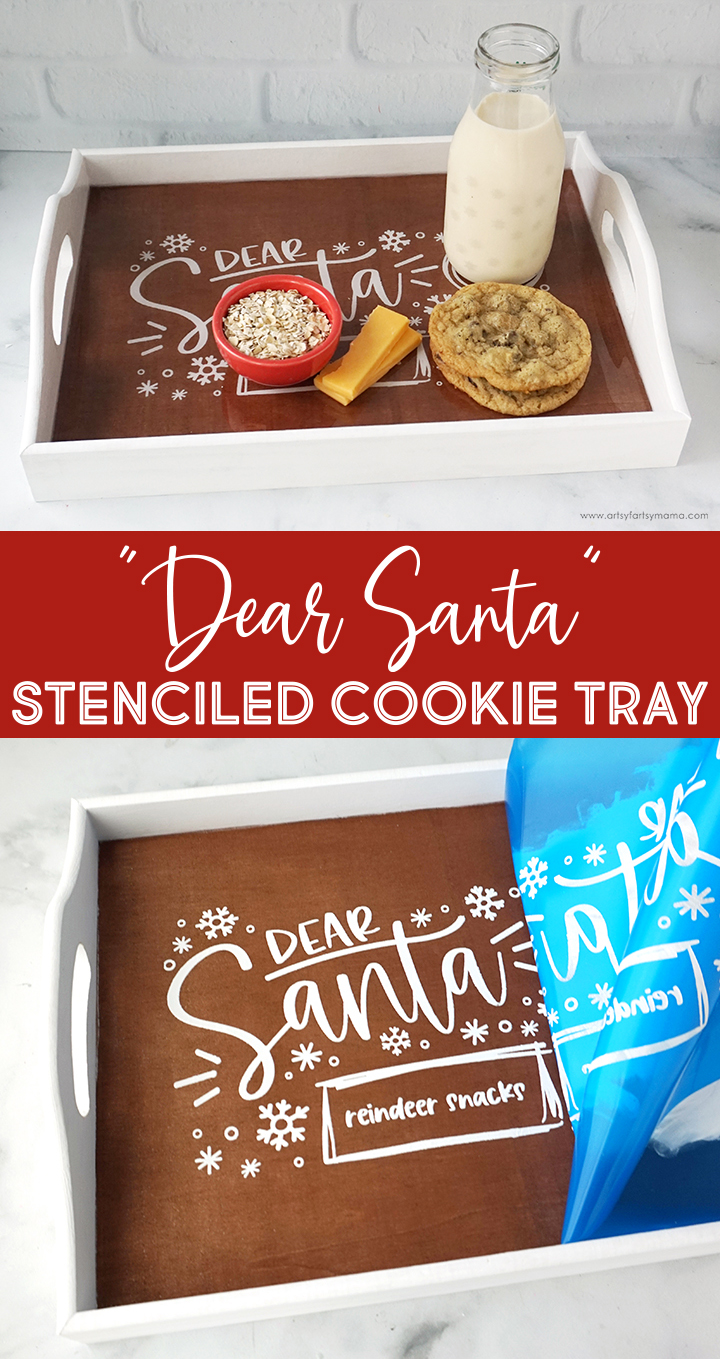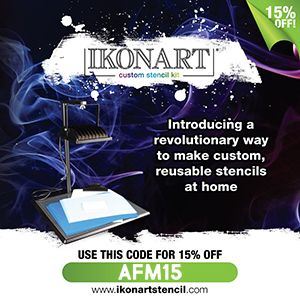Create a custom "Dear Santa" Christmas Cookie Tray to share your favorite holiday snacks with Santa Claus and his reindeer on Christmas Eve!

One of my favorite Christmas Eve traditions is spending the afternoon baking fresh cookies and putting together other goodies for Santa! Instead of displaying everything on a plate, I decided to make a cookie tray using a custom stencil I made using my Ikonart kit!! This was such a fun and simple project to make, and I absolutely love how it turned out. If you want to make a "Dear Santa" Christmas Cookie Tray for your own family to use, I'm sharing the FREE design to get you started!!
New to making reusable stencils? Here's how to Get Started with Ikonart!
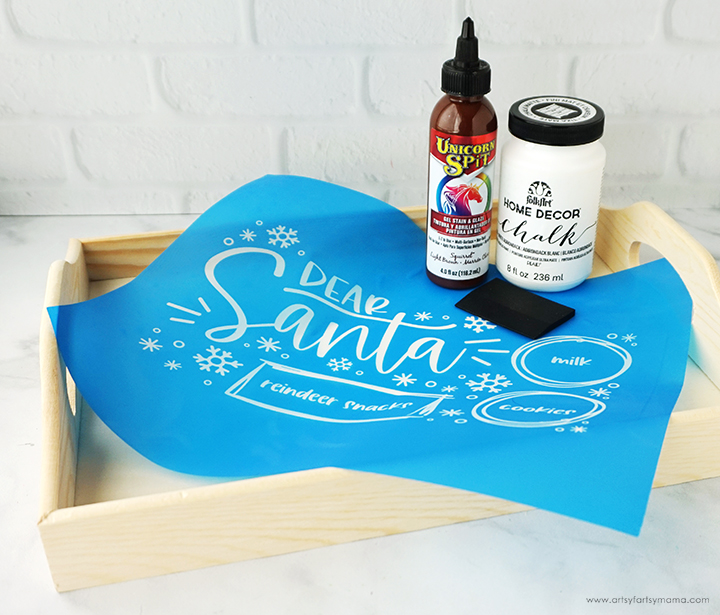
To make your own "Dear Santa" Christmas Cookie Tray, you will need these supplies:
- "Dear Santa" Cookie Tray Design (for personal use only)
- Ikonart Custom Stencil Kit*
- Scissors
- 11"x14" Unfinished Wood Tray
- Sandpaper
- Unicorn Spit Stain - brown
- Chalk Paint - white
- Paint Brush
- Detail Brush (optional)
- Squeegee
- Sealant
*Save 15% on Ikonart supplies when you shop with code AFM15

To make a stencil, you need to start with a printed design. Download the "Dear Santa" Cookie Tray Design (for personal use only) and print the design as dark as possible on either inkjet or laser Ikonart Printer Film.
The next step in the process is exposing the stencil film. Set up the exposure stand with UV LED Light by following the directions included in the kit. Ikonart Stencil Film is light sensitive, so be careful to keep it out of sunlight and bright lights before exposure. Cut a piece of the film the same size as the design print.
Lay the piece of film down on the base of the stand with the textured side facing up. Place the printed design on top of the stencil film, making sure it's right-side up - meaning that you should be able to read the words printed on the design.
Lastly, place the clear exposure sheet (found in the stencil film pack) on top and press it down well to seal the design tight against the stencil film. Turn the exposure light on and expose the film for 35 seconds.
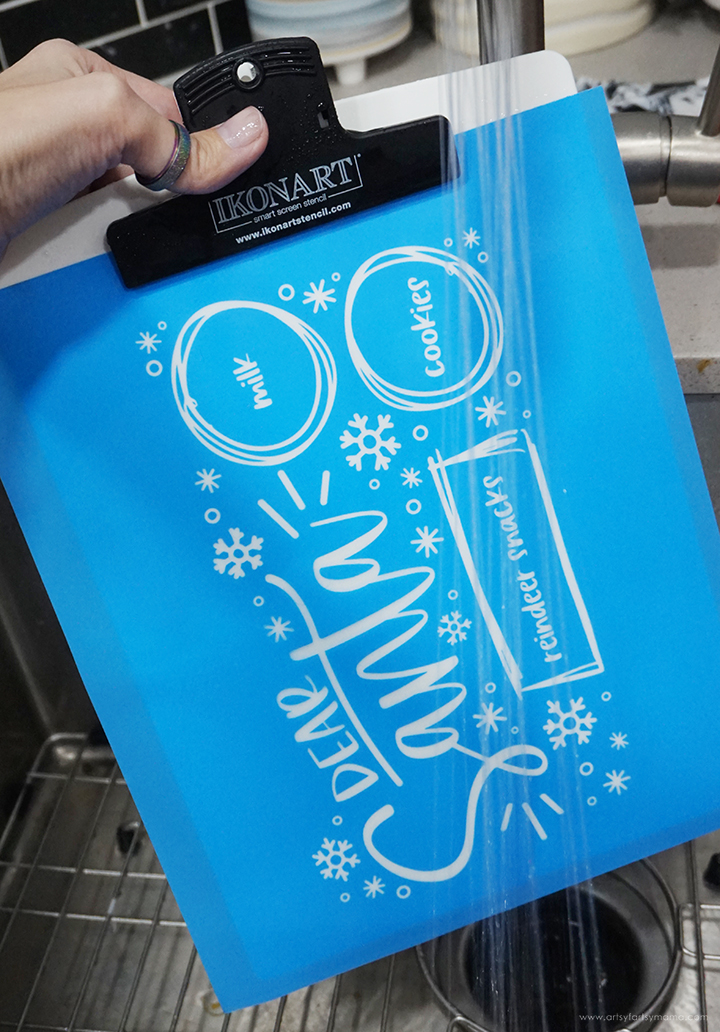
The final step in the stencil-making process is to washout, or rinse the stencil. Clip the exposed stencil film to the Ikonart clipboard with the shiny side (carrier sheet) touching the clipboard. Use the kitchen sink sprayer to rinse the stencil film with warm water until the design shows through and becomes completely clear. The washout process shouldn't take more than 3 minutes.
Gently blot the excess water from the stencil, and hang or lay the stencil flat to dry for about 45 minutes. When the stencil is dry, you shouldn't see any water spots or discoloration. Once the stencil is completely dried, place the it back on the exposure stand and expose it again for at least 2 minutes without the clear cover sheet. This extra exposure time will increase the durability of the stencil so you can get as much use out of it as possible.

While the stencil is drying, get the tray ready to be stenciled. I used an 11"x14" unfinished wood tray, Unicorn Spit Stain in "Squirrel" (brown), and some Unicorn Spit Metallic for some added sparkle. Unicorn Spit is a fantastic gel stain for unfinished wood projects. Not only does it smell great, but the coverage is amazing!
I filled a small mixing cup halfway with water, and then added both Unicorn Spit stains. Mix the stain with the water until completely combined. Sand the tray, if necessary, so that it's as smooth as possible. Use a paint brush to carefully paint just the inside base of the tray. Let the stain dry, and add another coat, if needed.
*While Unicorn Spit is washable, wear gloves if you are worried about staining your hands!
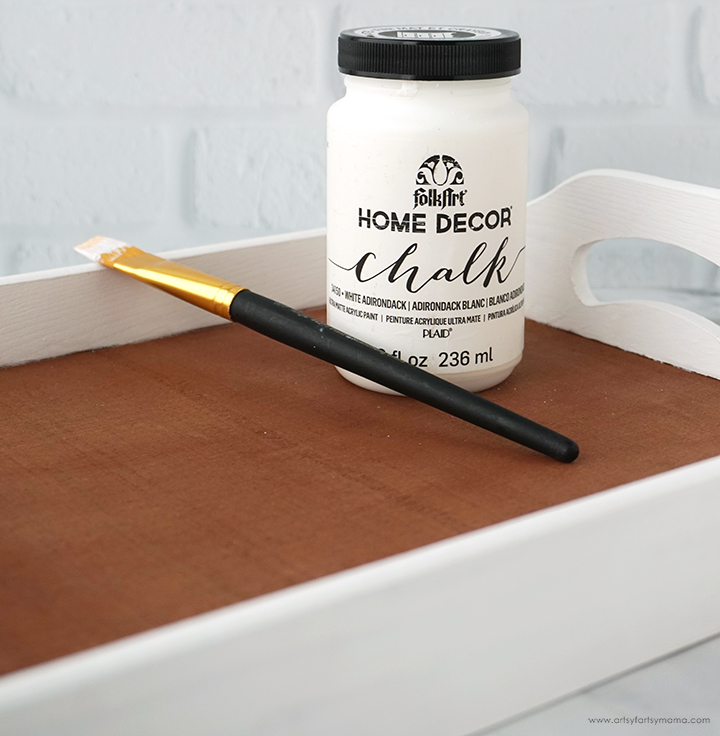
I painted the tray frame with a couple coats of white chalk paint for some contrast. Be careful painting where the frame meets the stained tray base. As long as the stain is dry, you can put some painters tape down around the edges. Be sure to let each coat of paint dry completely before adding another.

Use a permanent marker and write "back" on the carrier sheet (shiny side) on the back of the stencil. Peel the carrier sheet away from the stencil and set it aside (don't throw it away). Place the stencil down in the center of the tray (I like to use a measuring tape to make sure it's centered). Carefully rub the stencil down and apply pressure to help it stick to the surface and to get rid of any air bubbles.
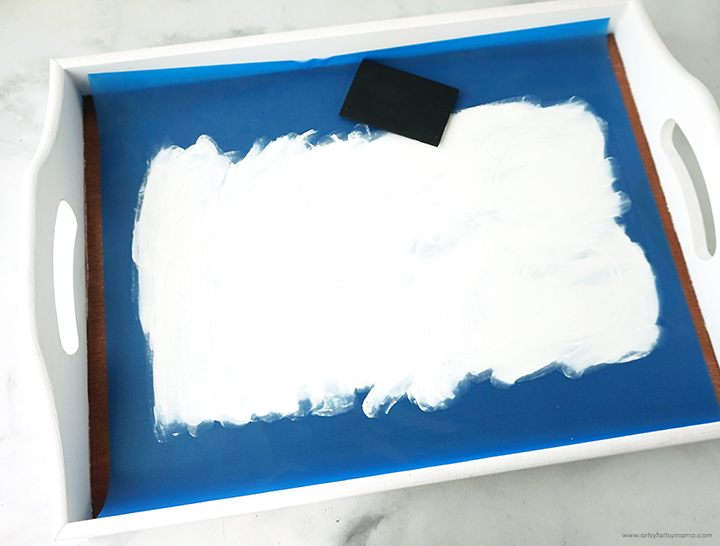
Chalk paint is a great paint to use for stenciling because it's thicker, so it makes crisp lines through the stencil. Acrylic paint can also be used, but it has a thinner consistency. To thicken your acrylic paints (any brand or type), I recommend mixing in a little bit of chalk paint powder. Just add a little bit of powder to the paint and stir it together with a craft stick. Add a little more powder at a time, if necessary, until you get the consistency you want.
Add a line of paint right above the stencil design, and gently pull the squeegee down over the stencil until it is all evenly covered. Scrape away the excess and put it back into the bottle. Chalk paint is thicker, but it also is important to note that it does dry more quickly than acrylic paint, so I would recommend working quickly to prevent the paint from drying in the mesh and lifting up with your stencil.
If you're not sure what to use on your project, Ikonart has a list of paint and ink selections to help you out!

After covering the stencil, lift it up slowly to reveal the design and look carefully for any spots that you may have missed. If you did miss anything, carefully lay the stencil back down and add a little more paint over the area.

Once the stencil is completely lifted, it's almost impossible to put the stencil back down correctly to make any adjustments. If you need to fill in any areas, I would recommend using a detail brush to add more paint.
Wash your stencil so that it can be used again and again. First, get the clipboard wet so your stencil doesn't stick to it. Place the stencil on the clipboard with the textured side up, and lightly rub the stencil under cold running water to remove all the paint.
Do not rub or scrub the adhesive side of the stencil, and NEVER use anything other than water to wash the stencils. To prevent the stencil from breaking down, don't ever leave the stencils to soak.
Remove the stencil from the clipboard and lay it down with the adhesive side up. While the stencil is still wet, place the carrier sheet onto the stencil so that the word “BACK” is readable. Hang or lay the stencil flat to dry completely.

To protect the tray from liquids and to keep it lasting as long as possible, cover the tray with a coat or two of sealant. If adding multiple coats, be sure to let the previous coat dry completely before adding another.
In addition to sealant, I also covered the tray in a coat of resin. Working with resin can feel intimidating to beginners, but adding a resin topcoat is incredibly simple! In fact, I'm sharing the complete process for covering this tray with resin on the Resin Crafts Blog!
*Save 10% on resin supplies when you shop ETI with code AFM

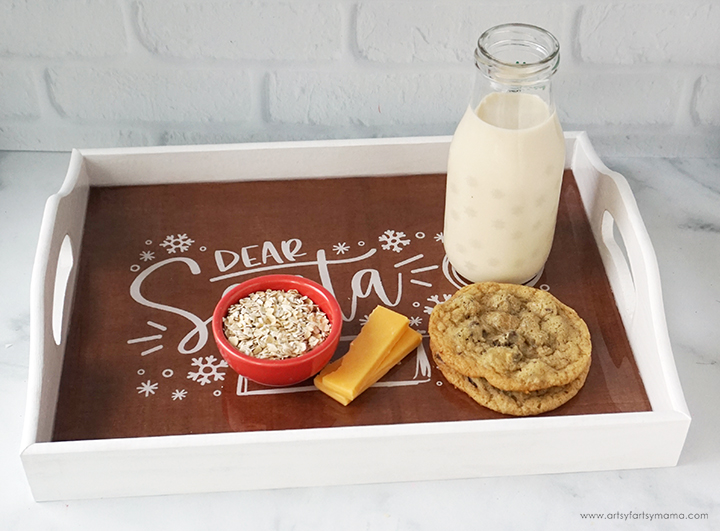
I had so much fun making this "Dear Santa" Christmas Cookie Tray, and can't wait for Christmas to get here so we can officially put it to use! I'd love to hear what you think about this project, or if you are interested in trying out reusable stencils. As always, I would love to see your creations! Share yours on Instagram, Facebook, or leave a comment/photo on the project pin on Pinterest! #AFMCrafts
Don't forget to Pin, Like, and Share!
